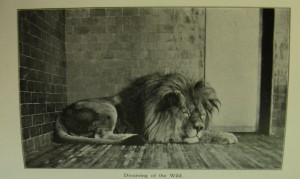By Rebecca Onion
 As a historian interested in the way that animals and humans have co-existed, I’m forever on the lookout for animal stowaways—the secret passengers lurking in primary sources. I found plenty in Esther Singleton’s The Children’s City, published in 1910. This book, intended for young readers, is the story of two bored young New Yorkers, Nora and Jack, whose adult acquaintance Doodle (these were less anxious times) tours them around the city in an attempt to show them that the place where they live is full of interesting things. Doodle, Nora, and Jack visit the Aquarium, the Bronx Zoo, the American Museum of Natural History, and the Botanical Garden. Along the way, they meet an impressive cast of animal prisoners. Doodle’s storytelling about these trapped beasties isn’t meant to create sympathy, but rather to impress his charges; a modern eye might see things differently.
As a historian interested in the way that animals and humans have co-existed, I’m forever on the lookout for animal stowaways—the secret passengers lurking in primary sources. I found plenty in Esther Singleton’s The Children’s City, published in 1910. This book, intended for young readers, is the story of two bored young New Yorkers, Nora and Jack, whose adult acquaintance Doodle (these were less anxious times) tours them around the city in an attempt to show them that the place where they live is full of interesting things. Doodle, Nora, and Jack visit the Aquarium, the Bronx Zoo, the American Museum of Natural History, and the Botanical Garden. Along the way, they meet an impressive cast of animal prisoners. Doodle’s storytelling about these trapped beasties isn’t meant to create sympathy, but rather to impress his charges; a modern eye might see things differently.
There’s Silver King, a gigantic polar bear whose transition to captivity didn’t go so well (“twenty men worked ten hours before they could get him off the boat and into his den in the Zoological Park…he fought so desperately that they had to chloroform him and it took four pounds of chloroform to make him quiet!”) Denizens of the aquarium resist captivity as well, Doodle adds. “Sometimes a fish will refuse to eat for days,” Doodle says, “as did the large Moray that came from Bermuda. At one time this great eel fasted for eighteen days, and at another time for twenty-seven, thus causing its caretakers the utmost anxiety.” Was the eel sick, or “moping,” as Doodle calls it? Either way, the children shouldn’t worry—the aquarium has “hospital-tanks” that can deal with the problem.
Then there’s Lopez the Jaguar. Doodle tells the story of how Lopez was captured in Paraguay, then transported on a small boat and “nearly drowned” several times, before saying, confidentially, “I know something about Lopez that does not speak well for his character.” Lopez had killed a female jaguar that was put in his cage. “The murder was fully premeditated,” Doodle adds to his wondering audience. “As a consequence of this act of treachery, Lopez will live in solitude the remainder of his life.” How is this “living in solitude” very much more of a punishment than being trapped indefinitely in a zoo? Doodle doesn’t say.
Plate from Esther Singleton, The Children’s City (New York: Sturgis & Walton, 1910)
Rebecca Onion is a graduate student in the Department of American Studies at the University of Texas at Austin, and is currently finishing up a dissertation about popular science and American childhood. Her research blog, Songbirds & Satellites, is at www.rebeccaonion.com
